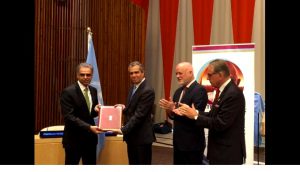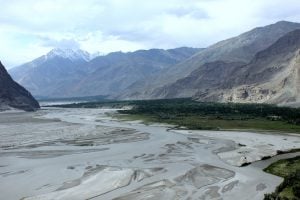India will ratify the Paris Climate Agreement on October 2, the birth anniversary of Mahatma Gandhi, exactly a year after the government announced its Intended Nationally Determined Contribution (INDC) to combat climate change.
Prime Minister Narendra Modi made the announcement at a conclave of India’s ruling Bharatiya Janata Party. The decision will have to be endorsed by the union cabinet. After the Prime Minister’s announcement, the endorsement is expected to be a formality.
Once India’s ratification becomes official, the Paris Agreement would have been ratified by over 60 countries, together responsible for 52.26% of global greenhouse gas (GHG) emissions that are warming up the atmosphere. To come into force, the Paris Agreement needs ratification from at least 55 countries, collectively responsible for at least 55% of global GHG emissions.
Officials at the United Nations Framework Convention on Climate Change (UNFCCC) are hoping that more countries will follow India soon and the 55% mark will be crossed before the start of the next UNFCCC summit in Marrakech, Morocco, on November 7.
India is the world’s third largest GHG emitter after China and the US, which had both announced ratification at the recent G20 summit in Hangzhou, China. Arvind Panagariya, the Prime Minister’s chief aide at that summit, had said at the time that India was not in a position to ratify the Paris Agreement in 2016 due to “domestic compulsions”.
See: India dithers as China and the US ratify Paris pact
Now, with his announcement, Modi has turned around a position taken by Indian diplomats, who sought to link the ratification to India’s entry into the powerful Nuclear Suppliers’ Group (NSG) of countries. Indian diplomats had been unhappy because China had blocked India’s entry to the NSG. But veteran climate negotiators once attached to India’s Ministry of Environment, Forests and Climate Change (MOEFCC) had warned that this linkage would be opposed by many countries. The US government, in particular, is very keen that the Paris Agreement comes into force before President Barack Obama leaves office in January.
The diplomats had advanced the argument that India would need to be in the NSG to fulfil the commitments made in its INDC, but calculations made by independent think tanks in New Delhi had shown that this was incorrect. These calculations were made for the MOEFCC as part of its preparation for the next “national communication” to the UNFCCC about what India is doing to combat climate change.
There was further diplomatic pressure on India when another emerging economy, Brazil, ratified the Paris Agreement recently. Veteran climate negotiators pointed out to Environment Minister Anil Dave that India risked being isolated at the next climate talks.
See: New Brazilian government ratifies Paris Accord
Designing the world after 2020
Lack of ratification would have left India out of the group of countries that will design the world after 2020, especially in the field of energy production and use. The Paris Agreement is scheduled to come into effect in 2020. Lack of ratification would have also weakened India’s long-held stand to ask advanced economies to do more to combat climate change between now and 2020.
There are indications that India may change its stance in related negotiations as well. The Marrakech summit will be preceded by an important meeting in Kigali, Rwanda, about the phase-out of hydrofluorocarbons (HFCs) which are used as coolants in air-conditioners and refrigerators but are also powerful greenhouse gases. The Indian government had earlier been insisting on 2030 as the final phase-out year, but now it may agree with the US proposition that all HFCs be phased out by 2025.
![<p>Narendra Modi addressing the Innovation Summit in COP 21, Paris, France [image by PIB]</p>](https://dialogue.earth/content/uploads/2016/09/l2015120174103.jpg)






